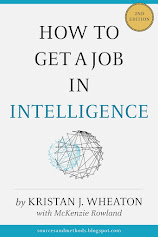TechCrunch points to a very interesting presentation on the future of search on the web. The article, quoting extensively from a Radar Networks presentation (see below) on the future of finding stuff on the web, makes some very interesting points. Both the article and the slides below are worth the time to read them.
Saturday, April 26, 2008
Is Keyword Searching Dead? (Radar Networks Via TechCrunch)
Posted by
Kristan J. Wheaton
at
7:40 AM
0
comments
![]()
Labels: search, TechCrunch
Friday, April 25, 2008
Syrian Nuclear Reactor Video (USIC via Veoh)
The recent release of the US Intelligence Community's (USIC) video interpretation of the purpose of a Syrian facility bombed by the Israeli's back in September, 2007 is an interesting story but is even more interesting as an example of how the IC "translates" intelligence reports from their traditional print format (with a few graphics) to a primarily multimedia format with just enough text to highlight the findings.
We have run these kinds of projects for a number of years here (in our Intelligence Communications classes) and I have found that the most difficult thing to do is to make the video without coming across as "selling" the finding. I think the analysts and production people who did this report met that goal, at least, successfully (though you do wish that a 50 billion dollar organization would have been able to find a better microphone...). See for yourself:
Posted by
Kristan J. Wheaton
at
5:32 PM
0
comments
![]()
Labels: nuclear proliferation, Syria, video
Middle East Dynamics, Challenges Facing Colombia And Robert Mueller On Intelligence Gathering (Fora.tv)
Fora has changed its format a bit, making it easier to watch full programs or just interesting snippets. The items below are taken from Fora's offerings over the last week.
Parag Khanna on Middle East Dynamics
Parag Khanna, author of The Second World, divides the Middle East into three distinct regions with unique political issues and highlights the rise of arabism and islamism, which permeates all three.
The Honorable William R. Brownfield on Colombia
Ambassador William R. Brownfield, United States Ambassador to Colombia outlines the current challenges facing Colombia and discusses the U.S.-Colombia relationship. Following his presentation, he answers questions from the audience.
FBI Director Robert Mueller on Intelligence Gathering
FBI Director Robert Mueller describes the subtleties of effective intelligence gathering, comparing it to panning for gold.
Posted by
Kristan J. Wheaton
at
1:28 PM
0
comments
![]()
Labels: Colombia, Fora.tv, intelligence, Middle East, video
Thursday, April 24, 2008
DRC: Opportunism Trumps Peace (ISN)
Brent Pearson, a first year graduate student here at Mercyhurst, has just published (at ISN) a very interesting analysis of the situation in the eastern provinces of the Democratic Republic of Congo. He claims that "The Armed Forces of the Democratic Republic of Congo (FARDC) and the United Nations Mission in the Democratic Republic of Congo (MONUC) are unlikely to be able to enforce Security Council resolutions and ceasefire agreements between the government and armed groups in the country's eastern provinces due to ethnic loyalties and opportunities to profit from illicit trading in minerals." The reasons for his position are worth the read (full text article here).
Posted by
Kristan J. Wheaton
at
12:39 PM
0
comments
![]()
Jihadist Use Of YouTube, Second Life Over Next 12-24 Months: An Estimate (Original Research)
A group of five students in my winter Strategic Intelligence class were asked to take a look at "the nature, volume, and likely current use of YouTube, other hosted video sites and Second Life by jihadist networks and individuals, and what will the likely future use of these mediums be over the next 12-24 months?" They started the project in early December, 2007 and finished it in mid-February, 2008.
With Congress' and the intelligence community's growing interest in the possibilities for terrorist use of virtual worlds and other Web 2.0 platforms, I thought these student's findings would be more than a little interesting to most readers of this blog. Since they used a wiki as the basic tool for collecting, analyzing and producing their intelligence report, it is pretty easy for me to share the findings (and point you to the key parts of the report).
The main entry page for their project is here (We used our old friends at Wikispaces again. As usual, the students were glad for the low barriers to entry at the beginning but were chafing a bit at the end. To get the look and feel they wanted, for example, they had to borrow some html code from another team and make it their own).
From the main page it is pretty easy to navigate to all of the parts of the wiki. You will likely want to start with the Key Findings which specifically addresses all of the issues in the requirement in the first paragraph above. In general, however, they found:
- "YouTube: The primary current and future nature of jihadist postings on YouTube and other hosted video sites over the next 12-24 months is likely propaganda and recruitment."
- "Western Europe will likely be the main region for jihadist use of YouTube due to readily available broadband internet access, a large population of disaffected Muslims, and the location of their target audience, who are young, Western European Muslims."
- "YouTube will likely remain the top video hosting website for jihadist videos over the next 12-24 months..."
- "Law enforcement will unlikely be able to keep pace with the number of jihadist postings over the next 12-24 months."
- "Second Life: Jihadists are likely currently very minimally using Second Life (SL)...
- "...over the next 12-24 months jihadists will likely begin to explore the ability and utility of the virtual world's applications for money laundering, communication, and recruitment through propaganda...Use will likely be limited to merely exploring due to currently existing alternatives..."
- "The most effective countermeasures will likely rely on a close, working relationship with Linden Labs due to the systems in place to monitor financial transactions, avatar activity, and communication."
As with other strategic intelligence projects, the primary goal is for the student-analysts in the class to learn what it takes to prepare and present strategic level intelligence to real world decisionmakers. The students do these projects on their own (with a little stick and rudder guidance from me) trying to use, in the process, all of the skills and knowledge they have acquired up to this point in their education. They have no additional resources (monetary or otherwise) and use only open sources. All of the projects last ten weeks from start to finish and none of them are perfect. Expert users of both of these services, for example, will undoubtedly find places where the analysis could have been tighter (Most of the time the students are climbing at least two learning curves -- the "what is strategic intelligence and how do you do it" curve combined, in this case, with the "I really need to know a lot more about YouTube and Second Life if I am going to analyze it" curve). As with all college students, this is just one of the classes and commitments they have to keep up with.
With these caveats in mind, I still think their product, particularly at the "higher" levels of analysis, adds value to the discussion on this topic. The resource pages, spreadsheets and other custom products made for this project are worth the price of admission all by themselves. It is also another good example of how a wiki might be used to help the analytic process. Beyond the collection and process value of the product, I think they have managed to avoid all of the hyperbole surrounding this issue and have offered a sober, nuanced and fact-based estimate regarding the potential for use (and misuse) of these two web-based tools. I thought it was worth sharing.
Related Posts:
A Wiki Is Like A Room...And Other Lessons Learned
Non-State Actors In Sub-Saharan Africa: Likely Current And Future Roles
Posted by
Kristan J. Wheaton
at
8:00 AM
0
comments
![]()
Labels: intelligence, intelligence analysis, Second Life, strategic intelligence, wiki, YouTube




